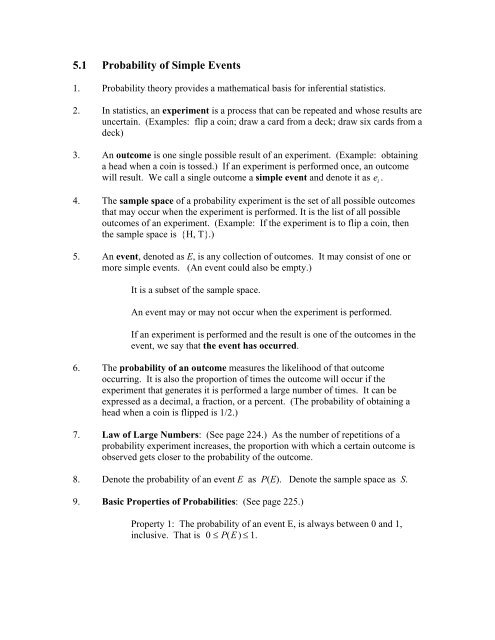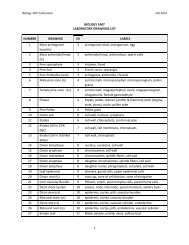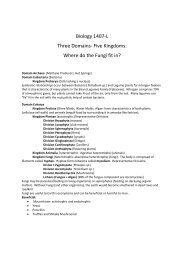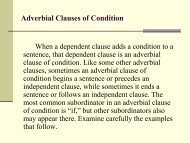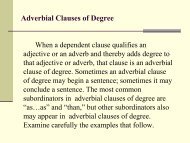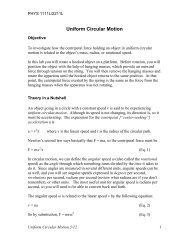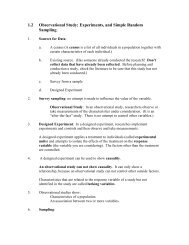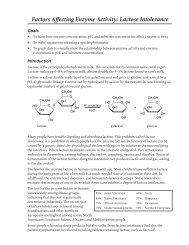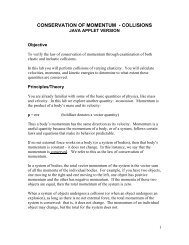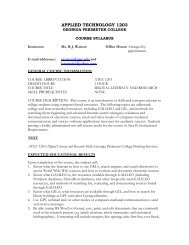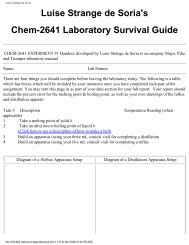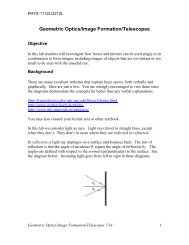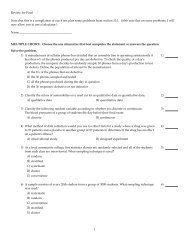5.1 Probability of Simple Events
5.1 Probability of Simple Events
5.1 Probability of Simple Events
Create successful ePaper yourself
Turn your PDF publications into a flip-book with our unique Google optimized e-Paper software.
<strong>5.1</strong> <strong>Probability</strong> <strong>of</strong> <strong>Simple</strong> <strong>Events</strong><br />
1. <strong>Probability</strong> theory provides a mathematical basis for inferential statistics.<br />
2. In statistics, an experiment is a process that can be repeated and whose results are<br />
uncertain. (Examples: flip a coin; draw a card from a deck; draw six cards from a<br />
deck)<br />
3. An outcome is one single possible result <strong>of</strong> an experiment. (Example: obtaining<br />
a head when a coin is tossed.) If an experiment is performed once, an outcome<br />
will result. We call a single outcome a simple event and denote it as e i<br />
.<br />
4. The sample space <strong>of</strong> a probability experiment is the set <strong>of</strong> all possible outcomes<br />
that may occur when the experiment is performed. It is the list <strong>of</strong> all possible<br />
outcomes <strong>of</strong> an experiment. (Example: If the experiment is to flip a coin, then<br />
the sample space is {H, T}.)<br />
5. An event, denoted as E, is any collection <strong>of</strong> outcomes. It may consist <strong>of</strong> one or<br />
more simple events. (An event could also be empty.)<br />
It is a subset <strong>of</strong> the sample space.<br />
An event may or may not occur when the experiment is performed.<br />
If an experiment is performed and the result is one <strong>of</strong> the outcomes in the<br />
event, we say that the event has occurred.<br />
6. The probability <strong>of</strong> an outcome measures the likelihood <strong>of</strong> that outcome<br />
occurring. It is also the proportion <strong>of</strong> times the outcome will occur if the<br />
experiment that generates it is performed a large number <strong>of</strong> times. It can be<br />
expressed as a decimal, a fraction, or a percent. (The probability <strong>of</strong> obtaining a<br />
head when a coin is flipped is 1/2.)<br />
7. Law <strong>of</strong> Large Numbers: (See page 224.) As the number <strong>of</strong> repetitions <strong>of</strong> a<br />
probability experiment increases, the proportion with which a certain outcome is<br />
observed gets closer to the probability <strong>of</strong> the outcome.<br />
8. Denote the probability <strong>of</strong> an event E as P(E). Denote the sample space as S.<br />
9. Basic Properties <strong>of</strong> Probabilities: (See page 225.)<br />
Property 1: The probability <strong>of</strong> an event E, is always between 0 and 1,<br />
inclusive. That is 0 ≤ P(E ) ≤ 1.
Property 2: The sum <strong>of</strong> all <strong>of</strong> the probabilities <strong>of</strong> all simple events is 1.<br />
That is, if S = {e 1<br />
, e 2<br />
, ...,e n<br />
} is the sample space <strong>of</strong> an experiment, then<br />
P(e 1<br />
) + P(e 2<br />
) + ...+ P(e n<br />
) =1.<br />
10. A probability model lists each possible outcome together with its probability.<br />
The probability model must satisfy properties 1 and 2 above.<br />
11. The probability <strong>of</strong> an event that cannot occur is 0. (An event that cannot occur is<br />
called an impossible event.)<br />
The probability <strong>of</strong> an event that must occur is 1. (An event that must occur is<br />
called a certain event.)<br />
12. If an event has a probability near 0 (or 0%), it is not very likely to occur. If an<br />
event has a probability near 1 (or 100%), it is very likely to occur.<br />
13. An unusual event is an event that has a low probability <strong>of</strong> occurring. (Typically,<br />
but not always, it has a probability less than 5%.)<br />
14. There are three methods for determining probabilities, the classical method, the<br />
empirical method and the subjective method.<br />
15. Empirical Probabilities: (Based on counting the number <strong>of</strong> times an outcome<br />
occurs when as experiment is performed repeatedly.) See page 226.<br />
The probability <strong>of</strong> an event E is approximately the number <strong>of</strong> times event E<br />
occurs divided by the number <strong>of</strong> repetitions <strong>of</strong> the experiment.<br />
frequency <strong>of</strong> E<br />
P(E ) ≈ relative frequency <strong>of</strong> E =<br />
number <strong>of</strong> trials <strong>of</strong> the experiment<br />
16. Note that probabilities calculated using the empirical approach are approximate.<br />
By the Law <strong>of</strong> Large Numbers, probabilities calculated with this approach will<br />
become closer to the true probability as the number <strong>of</strong> trials increases.<br />
17. Classical Method: <strong>Probability</strong> for Equally Likely Outcomes: (See page 227.)<br />
An experiment is said to have equally likely outcomes if each outcome has an<br />
equal chance <strong>of</strong> occurring.<br />
Let n be the number <strong>of</strong> possible equally likely outcomes <strong>of</strong> an experiment or<br />
game. Let m be the number <strong>of</strong> ways that a specified event can occur. Then the<br />
probability that the event E, occurs is m/n.<br />
P(E) =<br />
Number <strong>of</strong> ways the event can occur<br />
Total number <strong>of</strong> possible outcomes = m n .
P(E) = N(E) , where N(E) is the number <strong>of</strong> outcomes in the event E,<br />
N(S)<br />
and N(S) is the number <strong>of</strong> outcomes in the sample space.<br />
18. Subjective probabilities are probabilities obtained based upon an educated guess.<br />
Each person could have a different probability for an event, based on the way they<br />
interpret the relevant information. Therefore, subjective probabilities should be<br />
interpreted with skepticism.


